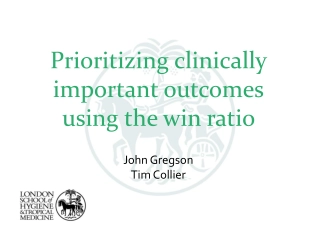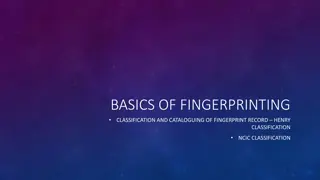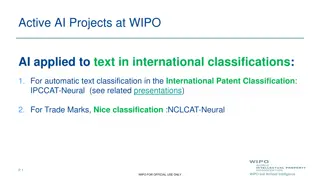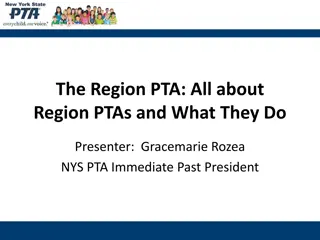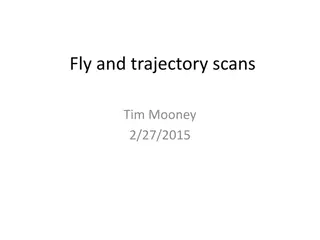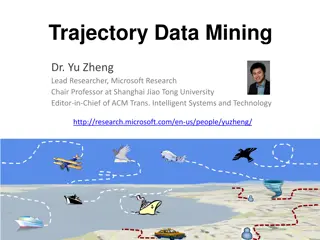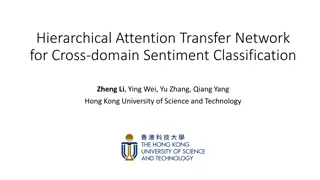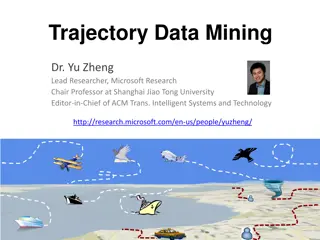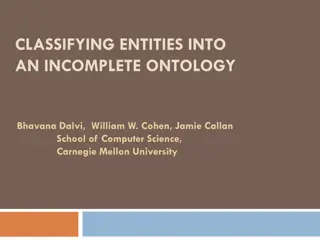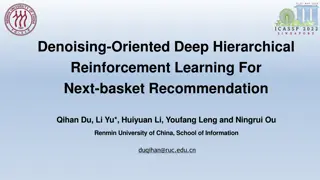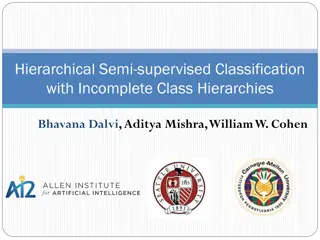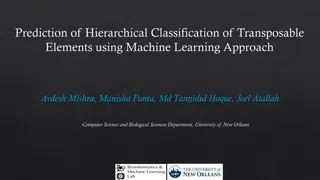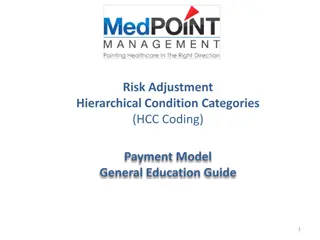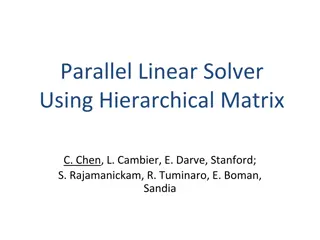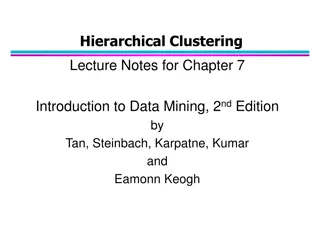Trajectory Classification Framework Using Hierarchical Region and Trajectory-based Clustering
This paper introduces TraClass, a novel framework for trajectory classification that focuses on effective feature generation. It addresses challenges in classifying trajectories by proposing a method that partitions trajectories, performs region-based clustering, and trajectory-based clustering. The framework demonstrates high classification accuracy with real trajectory data.
Download Presentation

Please find below an Image/Link to download the presentation.
The content on the website is provided AS IS for your information and personal use only. It may not be sold, licensed, or shared on other websites without obtaining consent from the author.If you encounter any issues during the download, it is possible that the publisher has removed the file from their server.
You are allowed to download the files provided on this website for personal or commercial use, subject to the condition that they are used lawfully. All files are the property of their respective owners.
The content on the website is provided AS IS for your information and personal use only. It may not be sold, licensed, or shared on other websites without obtaining consent from the author.
E N D
Presentation Transcript
1 TRACLASS : TRAJECTORY CLASSIFICATION USING HIERARHICAL REGION-BASED AND TRAJECTORY-BASED CLUSTERING JaeGil Lee, Jiawei Han, Xiaolei Li, Hector Gonzalez Department of Computer Science University of Illinois at Urbana Champaign Presented by Kajol UH ID : 1358284
2 PURPOSE OF THE PAPER Purpose of the paper is to perform Trajectory Classification. Trajectory Classification It is the process of predicting the class labels of moving objects based on their trajectories and other features. It tracks objects movements and collect huge amounts of trajectory data, e.g, animal movement data, vessel positioning data, and hurricane tracking data Application Scenarios 1. Vessel classification from satellite images Used in number of applications like fishery control, pollution control, border control including illegal immigration and smuggling, maritime safety, search and rescue, and anti-terrorism 2. Classification of trace gas measurements Trace gas (e.g., ozone) concentration is closely related to the immediate history of the air before arriving at the sampling point. Thus, trace gas concentration can be estimated using wind trajectories..
3 TRAJECTORY CLASSIFICATION Challenges in Trajectory Classification Trajectory is a sequence of points that has no attributes thus SVM or decision trees cannot be used with them. Earlier shape of the whole trajectories was used for classification but discriminative features appear at parts of trajectories In this paper focus is on feature generation for trajectories because essential task for effective classification is generating discriminative features. TraClass , a feature generation framework is proposed .It represents regions and sub trajectories. It performs: 1. Trajectory partitioning : It is based upon the partition and group framework 2. Region based Clustering : It uses MDL principle 3. Trajectory based Clustering : It is based upon the partition and group framework Experimental results demonstrate that TraClass generates high-quality features and achieves high classification accuracy from real trajectory data.
4 WORKING EXAMPLE Consider set of trajectories from two classes , class c1 , solid lines and class c2, dashed lines Region-based clustering It discovers regions that have trajectories mostly of one class regardless of their movement patterns. (1) B,F,H are homogeneous regions. (2) J is homogeneous Trajectory-based clustering It discovers sub-trajectories that indicate common movement patterns of each class. (1) Patterns 3,4,5,6 are discriminative (2) Patterns 7,8,9,10 are discriminative
5 TRACLASS FRAMEWORK
PROBLEM STATEMENT 6 Given: Set of trajectories = { TR1 , ..,TRnumtra } with each trajectory associated with a class c ? C = { c1, ,cnumcla } TR = p1p2p3..pj..plen then trajectory partition is a sub trajectory p of length 2. The whole trajectory and the trajectory partitions all belong to the same one class. Features, generated by two types of clustering, are provided to a classifier.
7 TRAJECTORY PARTITIONING The Partitioning Phase : Each trajectory is partitioned into a set of line segments (i.e., trajectory partitions)whenever its moving direction changes rapidly. The problem of finding the optimal set of such partitioning points is formulated by the MDL principle. The Grouping Phase: Similar line segments are grouped into a cluster using a density-based clustering method. A distance function for line segments dist (Li; Lj) is designed to define the density.
8 CLASS-CONSCIOUS PARTITIONING Some trajectory partitions need to be further partitioned by the class labels. The basic idea of class-conscious partitioning is to further partition a trajectory partition if the segments between two endpoints have very different class distributions. It ensures that the class distribution is kept uniform along a trajectory partition. To achieve this class-conscious partitioning, a heterogeneous trajectory partition is defined through Definitions 1 and 2. Definition 1. The class affinity of a point p is a vector CA(p) = {f1; f2; : : : ; fnumcla}, where f is the frequency of trajectory partitions whose class label is equal to i. Definition 2. A trajectory partition L = pspe is heterogeneous if argmaxk[CA(ps)]k argmaxk[CA(pe)]k. Here,[CA(.)]k denotes the frequency of trajectory partitions whose class label is equal to k, and argmaxk[CA(.)]k means theclass label with the maximum frequency in CA(.).
10 REGION-BASED CLUSTERING Region-based cluster contains many of trajectory partitions of one major class. It is formally defined through Definition 3 and 4. Definition 3. A region in a 2-dimensional space is homogeneous if only one class cmajor has trajectory partitions from trajectories within the region, but all other classes do not. The class cmajor is called the major class of the region, and other classes are called minor classes. designates the minimum population of the major class in a homogeneous region. Definition 4. A region-based cluster is a set of trajectory partitions of the major class within a homogeneous rectangular region.
11 CONSTRUCTION OF THE GRID STRUCTURE TraClass uses a multi-resolution grid structure to find the homogeneous regions, it quantizes the domain space into a finite number of cells. It crosses the partition of the X and Y axes and determines if each region is homogeneous or not. Good quantization is defined by two properties: homogeneity and conciseness. Homogeneity means that the class distribution in each region should be as homogeneous as possible; it is required for deriving more region-based clusters. Conciseness means that the number of regions should be as small as possible; it is required for generating larger region-based clusters. Homogeneity and conciseness are rivalry measures.
12 FORMALIZATION OF MDL PRINCIPLE The MDL cost consists of two components , L(H) and L(D/H). Here, H means the hypothesis, and D the data L(H) is the length, in bits, of the description of the hypothesis L(D/H) is the length, in bits, of the description of the data when encoded with the help of the hypothesis. In our quantization problem, H corresponds to the partitions of the X and Y axes, and D to the class labels of trajectory partitions. As a result, finding a good quantization translates to finding the best hypothesis using the MDL principle. Finding the quantization that minimizes L(H)+L(D/H) is exactly the tradeoff between homogeneity and conciseness. L(H) measures the degree of conciseness, and L(D/H) that of homogeneity.
13 FORMALIZATION OF MDL PRINCIPLE
15 RECURSIVE QUANTIZATION AND MERGING Shaded rectangle indicates the worst partition that has the maximum code cost Arrow a new partitioning point of the worst partition. After all possible homogeneous regions are discovered, adjacent regions can be merged to form larger regions. Two regions RHi and RHj are merged if , (i) RHi and RHj are adjacent to each other; (ii) RHi and RHj share the same major class; and (iii) the merger of RHi and RHj still forms a rectangle.
16 TRAJECTORY-BASED CLUSTERING A trajectory-based cluster is a density-connected set of trajectory partitions of the same class. It is represented by representative trajectory. Distance Function for Line Segments The distance function that we use is composed of three components (i) the perpendicular distance (ii) the parallel distance (iii)the angle distance It is defined as weighted sum of the three components
17 HOMOGENEITY OF AN ? ?-NEIGHBORHOOD To achieve class-conscious grouping, a homogeneous ? ?-neighborhood is defined. After an ? ?-neighborhood is computed, it is checked to determine if it is homogeneous by Definition 7. If the ? ?neighborhood is homogeneous, it is used for trajectory-based clustering. Otherwise, it is immediately discarded.
18 The time complexity of the algorithm in Figure 14 is O(n2)
19 ANALYSIS OF DISCRIMINATIVE POWER After trajectory-based clusters are found, TraClass selects those whose discriminative power is high enough for use in classification. Far-away located clusters of different classes are more discriminative than closely located clusters. Hausdorff distance measure is used. Distance between two clusters is calculated using two sets of line segments. L denotes the length of a line segment C , sum of the length of every line segment in C s representative trajectory.
20 The discriminative power of a cluster is called the separation gain and defined in Definition 8. Basically, it is the average distance from a specific cluster to other clusters of different classes. The larger the separation gain of a cluster is, the more likely the cluster is discriminative.
21 CLUSTER LINK GENERATION Classification accuracy can be improved further by using this methodology. To take advantage of the sequential nature of trajectory data, combined features are generated from a set of clusters. A combined feature is defined as a sequence of connectable clusters or connectable combined-features. , minimum commonness between two clusters or between combined features. Combined features are generated using Apriori-like algorithm.
22 A CLASSIFICATION STRATEGY A possible classification strategy is presented to use the features generated by TraClass. Advantages of TraClass 1) It is neutral to classifiers. That is, it can be used for any classifiers, including decision trees,rule-based classifiers, and support vector machines. 2) It can team up with other feature generation frameworks. Trajectories may have multiple numerical attributes in addition to a sequence of locations. We can use an existing framework for numerical attributes together with our framework for the trajectorial attribute. classifier is built using the support vector machine (SVM). The SVM is well-suited for such high- dimensional and sparse data
23 EXPERIMENTAL SETUP Fig: Three classes in the animal data. Uses three real trajectory data sets Animal Movement Data set The x and y coordinates are extracted for experiments. This data set is divided into three classes by species: elk, deer, and cattle. The numbers of trajectories (points) are 38 (7117), 30 (4333), and 34 (3540). 20% of trajectories are randomly selected for the test set. Vessel Navigation Data set The latitude and longitude are extracted for experiments. This data set is divided into two classes by vessel: Point Lobos and Point Sur. The numbers of trajectories (points) are 600 (65500) and 550 (125750), respectively. 20% of trajectories are randomly selected for the test set.
EXPERIMENTAL SETUP 24 Hurricane Track Dataset The latitude and longitude are extracted for experiments. A high category number indicates a high intensity. Categories 2 and 3 are chosen for two classes. The numbers of trajectories (points) are 61 (2459) and 72 (3126),respectively. 20% of trajectories are randomly selected for the test set. Classification accuracy, training time, and prediction time are measured for the three data sets. Classification accuracy is the ratio of the number of test trajectories correctly classified to the total number of test trajectories. TB-ONLY means the simple version that performs trajectory based clustering . RB-TB the full version that performs the two types of clustering ie. Region based and trajectory based.
EXPERIMENTAL RESULTS 25 thin gray lines represent trajectories thick color lines trajectory-based clusters thick color rectangles region-based clusters. A color represents a class.
26 Results for Animal Movement Data Results for Vessel Navigation Data
27 Results for Hurricane Track Data Results for Synthetic Data
28 CONCLUSION A novel and comprehensive feature generation framework for trajectories , TraClass has been proposed performs hierarchical region-based and trajectory-based clustering after trajectory partitioning. Experimental results demonstrates the generation of high quality accurate features. Classification results have demonstrated that performing both types of clustering improves classification accuracy as well as classification efficiency. Various real-world applications, e.g., vessel classification, can benefit from our framework.
29 PERSONAL CONCLUSION The good thing about the paper is that it presents a new approach to classify trajectory data accurately. It takes into account both region based and trajectory based clustering and clearly explains with results the importance of the combination. It introduces us to various algorithms and clearly walks through them. It talks about related work and various applications as well. Not many references are available with respect to this topic. Too many concepts within a single paper.
30 FUTURE DIRECTIONS AND REFERENCES Integration with numerical-feature generation frameworks is one of the challenges to be studied in the future. REFERENCES J. N. Cape, J. Methven, and L. E. Hudson. The use of trajectory cluster analysis to interpret trace gas measurements at Mace Head, Ireland. Atmospheric Environment, 34(22):3651{3663, 2000. J.-G. Lee, J. Han, and K.-Y. Whang. Trajectory clustering: A partition-and-group framework. In Proc. 2007 ACM SIGMOD Int'l Conf. on Management of Data, pages 593{604, Beijing, China, June 2007.
31 ANY QUESTIONS ?


